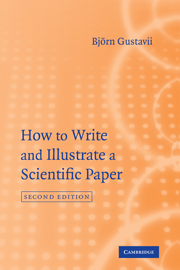Book contents
- Frontmatter
- Contents
- Preface
- Acknowledgments
- 1 Basic rules of writing
- 2 Comments on scientific language
- 3 Drafting the manuscript
- 4 Choosing a journal
- 5 Preparing a graph
- 6 Drawings
- 7 Figure legends
- 8 How to design tables
- 9 Title
- 10 Authors
- 11 Abstract
- 12 Introduction
- 13 Methods
- 14 Results
- 15 Discussion
- 16 Acknowledgments
- 17 References
- 18 Ph.D. and other doctoral theses
- 19 Letters and case reports
- 20 Numbers
- 21 Abbreviations
- 22 How to present statistical results
- 23 Typing
- 24 Dealing with editors and referees
- 25 Correcting proofs
- 26 Authors‘ responsibilities
- Literature needed on your desk
- Further reading
- Literature cited
- Index
8 - How to design tables
Published online by Cambridge University Press: 05 June 2012
- Frontmatter
- Contents
- Preface
- Acknowledgments
- 1 Basic rules of writing
- 2 Comments on scientific language
- 3 Drafting the manuscript
- 4 Choosing a journal
- 5 Preparing a graph
- 6 Drawings
- 7 Figure legends
- 8 How to design tables
- 9 Title
- 10 Authors
- 11 Abstract
- 12 Introduction
- 13 Methods
- 14 Results
- 15 Discussion
- 16 Acknowledgments
- 17 References
- 18 Ph.D. and other doctoral theses
- 19 Letters and case reports
- 20 Numbers
- 21 Abbreviations
- 22 How to present statistical results
- 23 Typing
- 24 Dealing with editors and referees
- 25 Correcting proofs
- 26 Authors‘ responsibilities
- Literature needed on your desk
- Further reading
- Literature cited
- Index
Summary
The content of a table may be either descriptive, as is most often the case, or declarative (bearing a message). It helps the reader if this is reflected in the table's title.
The descriptive title
The descriptive title is used for tables that present detailed information, such as the one below (only part of the original table is shown).
This table is from a paper of which I was a coauthor. Now, with the benefit of hindsight, I see that this title contains the common error of repeating every single heading, except, in this case, the first one. No fewer than 31 of the 39 words in the title can be deleted. The shortened version can be grasped at a glance:
The declarative title
If a table shows a clear trend or relationship, a declarative title could be preferable. The following table shows that the frequency of fractured clavicles increased with increasing birth weight.
But the title is neutral and one has to study the table for a while in order to grasp the message. It would have helped the reader if the table's message had been stated in the title:
Rounding off
In the table's far right-hand column, the percentages shown are overprecise. One decimal would suffice (see Chapter 20, “Percentages”).
- Type
- Chapter
- Information
- How to Write and Illustrate a Scientific Paper , pp. 42 - 47Publisher: Cambridge University PressPrint publication year: 2008



